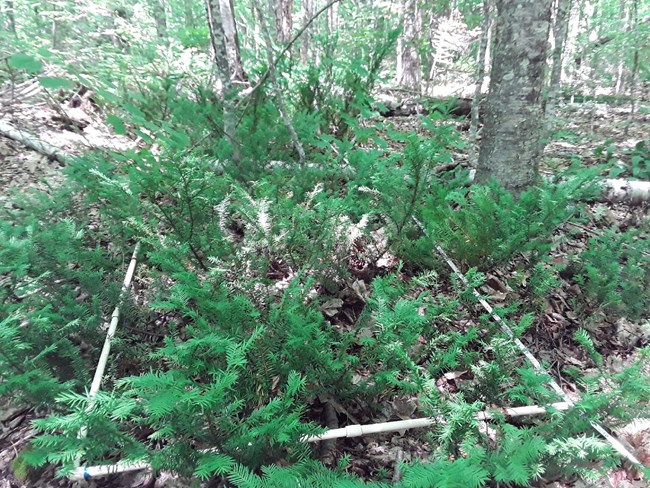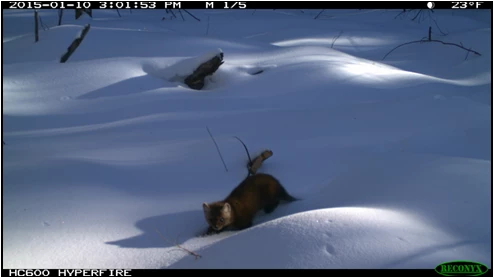Last updated: October 2, 2024
Article
Forest Health in the Apostle Islands, 2011–2021

NPS photo
We began long-term forest monitoring in the Apostle Islands in 2011 and returned in 2021 to resample the 48 original sites and establish two additional plots. Here, we examine changes over the 10-year interval.
Our monitoring plots are distributed among five broad forest types (Hemlock-hardwood, Aspen-birch, Cedar, Mountain maple-black ash, and Balsam fir) and three deer management zones (see table) within the park.
The consideration of deer management in our analyses is important because islands with no history of deer being on them harbor plant species and assemblages not commonly seen elsewhere in the region, including Canada yew (Taxus canadensis). This shrub has largely disappeared from the mainland due to fire, logging, and overbrowsing by deer, but it is abundant on several islands within the park. It is most abundant on islands with no known history of deer, but it is also common on islands where deer populations once occurred but are not currently found.
Deer management goals are set by the National Park Service for hunting on the islands. Browsing pressure exerted by deer on plant populations threatens to simplify the forest community (i.e., make it less diverse and resilient) and even cause some species to completely disappear from the islands.
| Deer Management Zone | No. of Monitoring Plots | Deer Management Goal |
|---|---|---|
| 1 | 18 | Few to no deer |
| 2 | 27 | Density at or below 10 deer/square mile (3.86 deer/square kilometer) |
| 3 (Mainland) | 5 | Set by the Wisconsin Department of Natural Resources |
What We Are Finding
Many Aspen-birch forests are now approximately 75 years old and dominated by maple trees. Regeneration of both hemlock (Tsuga canadensis) and yellow birch (Betula alleghaniensis) continues in Hemlock-hardwood sites, but both species have experienced small declines in density since 2011. Yellow birch is also regenerating in Balsam forests, but density has declined over the past 10 years.
We found broadscale declines in taxa richness and abundance throughout the park but particularly in Balsam fir forests (7.5 fewer taxa/site across all zones) and Hemlock-hardwood sites (1.8 fewer taxa/site across all zones). We also observed notable declines at Zone 1 sites, where deer impacts are minimal: Hemlock-hardwood sites lost 3.6 taxa/site, while Mountain maple-black ash sites declined by seven taxa/site. It appears that there is no single cause for these declines, but likely several contributing factors.

NPS photo
What Does It Mean?
Other studies identified deer browse, fire history, Canada yew cover, island size, and location within the archipelago as possible influences on the diversity and abundance of plants found on the islands. To these, we add the role of browsing by snowshoe hare and the influence of canopy closure.
Snowshoe hare were particularly abundant on Devils Island, where one of our four Balsam fir sites is located. One recent study estimated hare density on Devils Island to be 0.977 hares/hectare, which is seven times greater than the next highest density on South Twin Island (0.137 hares/hectare). The same study found few-to-no snowshoe hares near our other three Balsam fir forest sites. With only four sample sites in Balsam fir forest, declines in plant diversity and abundance at one site (Devils Island) has a significant effect on the overall change we see in that forest type.
Canopy closure is a slow process of expanding branches, leaves, and needles gradually blocking light from reaching the forest floor as trees grow taller. As this happens, plant species commonly found in open, sun-lit areas slowly give way to shade-tolerant species or to an open, unvegetated forest floor.
At one Mountain maple-black ash site on the southern end of Outer Island, richness declined from 63 taxa in 2011 to 38 taxa in 2021. This site is adjacent to a historic landing strip and appears to be transitioning away from an understory dominated by Rubus species (raspberries and blackberries) to a more open forest floor. Similar changes are occurring in the Hemlock-hardwood and Aspen-birch forest types.
Park-wide declines in richness make it difficult to understand browse impacts. Our four focal species––wild sarsaparilla (Aralia nudicaulis), rosy twisted-stalk (Streptopus lanceolatus var. roseus), clasping twisted-stalk (Streptopus amplexifolius), and bluebead lily (Clintonia borealis)––were found at fewer sites and at generally lower frequency within those plots during the second visit. Still, we did not see a clear relationship between the lower frequencies and plant height, as we would expect under high browse conditions. Further, declines in richness on islands with no or limited deer (Zone 1 sites) additionally confound the situation. A better understanding of broadscale species decline is needed before we can truly interpret browse impacts, both to herbaceous and woody species.
The frequency of Canada yew, an understory shrub highly preferred by white-tailed deer, remained unchanged in 25 of the 48 sites sampled in both years. At sites where frequency did change, it was generally by small declines or increases. However, larger declines in frequency were found at all three sites on Sand Island, one site on Cat Island, and one site on Stockton Island. Notable increases in yew frequency were found at the site on South Twin Island and one site each on Otter, Stockton, and Outer Islands.
What Can We Do?
There are three potential actions managers can take:
- In conifer forests, assessments of the coarse woody structure for marten habitat would be informative. (The marten is an endangered species in Wisconsin.) Knowing about characteristics of coarse woody material where marten are known to occur in the islands will allow for projections about other areas or islands that may be suitable marten habitat.
- Continue monitoring for invasive species, particularly invasive plants. We did not find any invasive plant species in our plots, but we did find five non-native plant taxa at sites in 2021. These were each limited to a small number of sites.
- We suggest managers monitor regeneration of yellow birch. Park-wide, we found a 32% decline in the abundance of small yellow birch saplings, with this drop most pronounced in Hemlock-hardwood and Balsam fir forests.
The current status of park forests is generally good, but we must remain vigilant to ecosystem health. Maintaining ecosystem structure or function is possible; restoring ecological integrity, however, may not be.

NPS photo
